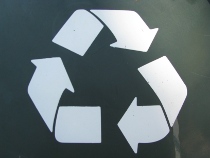The challenge of recycling
The task of greening the world economy and managing industrial and consumer waste has never been simple. Setbacks and complications are to be expected as the world tries to tackle the climate crisis with unprecedented effort.

 The task of greening the world economy and managing industrial and consumer waste has never been simple. Setbacks and complications are to be expected as the world tries to tackle the climate crisis with unprecedented effort.
The task of greening the world economy and managing industrial and consumer waste has never been simple. Setbacks and complications are to be expected as the world tries to tackle the climate crisis with unprecedented effort.
One challenge facing PLA bioplastics is how to streamline and guarantee the recycling process occurs properly. Although PLA bioplastic is designated by the US and EU as 100% biodegradable, the standards require that only that a material can be composted naturally and without a toxic by-product from 90-180 days to earn the biodegradable label.
Proper temperature, humidity and pressure conditions are required, and these conditions typically are not found in rubbish bins, land fills, or oceans.
Unfortunately, PLA bottles and packaging are not capable of the miraculous eco-friendly evaporation many wish for.
However, the act of producing PLA emits less CO2 and energy consumption is significantly lower than required to produce petrolplastics, and just because the conditions for decomposition are not readily met on a desktop or landfill does not mean they are that difficult to achieve.
Several options exist for the deposition of PLA, but two seem most desirable: one is biodegradation in a treatment plant; the other is recycling PLA into a new product.
Biodegradation by microbes under proper conditions retains all of the carbon used to make PLA in the environment, and keeps CO2 from entering the atmosphere. In addition, the biodegradation also creates a useful by-product that can be used as a fertilizer for additional bioplastic, or food crops.
The recycling option is equally or more attractive. Unlike petrolplastic, PLA is 100% recyclable. Even when PET (polyethylene terephthalate) or polyethylene plastics are recycled, the process requires huge expenditures of time and energy, and the end result is a product inferior to the original.
Bags and bottles are not recycled back into bags and bottles but instead into upholstery, shoes, and vinyl. By contrast, the quality of PLA does not decline upon recycling, and it instead can be broken back into the Polylactic Acid mould and reconstituted into the original product.
Yet, it is the physical and mental concentration required to recycle both petrolplastic and PLA that may pose the greatest challenge. Introducing PLA further complicates the recycling problem.
Already, petrolplastics are difficult to separate and must be done by hand-PP, LDPE, HDPE, PET, PVA must all be separated by label recognition.
Adding PLA, which can be indistinguishable to PET, will make the process more complicated as PLA is entirely unsuited for the petrol plastic recycling process, and must undergo its own recycling process to be effectively reused.
This will put more strain on an already marginally successful plastic recycling effort, but bioplastic companies are working on solutions to make sure PLA is as ecofriendly and as easily recycled as possible.
Natureworks llc, a leading US PLA manufacturing, is developing three solutions: Infrared, black light and product labelling. Different wavelengths of light reflect off of PET and PLA differently, producing easily distinguishable colours of infrared systems.
This can make sorting to the bioplastic from petrolplastic far easier. The results of blacklight testing are still in progress, but if they prove successful, blacklights would provide a cheaper and more energy efficient alternative technique as compared to the infrared system. Product labelling would likely provide the simplest solution.
However, labels would rely on consumers to sort through the rubbish and properly dispose of it. As bioplastics are produced on a wider scale, additional treatment centres will also be required to meet disposal needs.
Author: Michael Good |Climate Action
Image: TheTruthAbout... |Flickr






